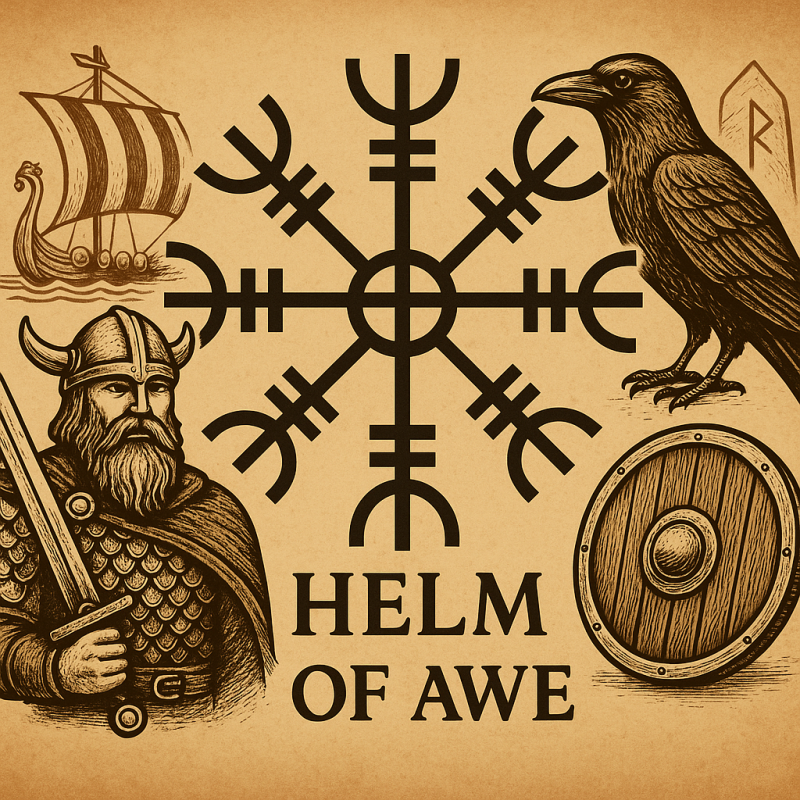Uncategorized
Helm of Awe (Aegishjalmur): The Viking Symbol of Power, Protection, and Fearlessness
Discovering the Mystique of Viking Symbols
The Viking Age evokes images of fearless warriors, majestic longships, and mysterious runes. At the heart of this rugged world lies a deep connection to symbols and sacred sigils believed to carry immense spiritual power.
Among them, the Helm of Awe, or Aegishjalmur, stands out as one of the most powerful protective emblems z a symbol etched not only on weapons and armor but into the identity of the Viking warrior spirit.
This article uncovers the origins, meaning, and modern fascination with the Helm of Awe — from ancient texts to its striking resurgence in tattoos and Norse-inspired fashion today.
Where Did the Helm of Awe Come From?
Ancient Texts and Viking Beliefs
The Poetic Edda and Prose Edda, Icelandic manuscripts that preserve Norse myth and lore, mention the Helm of Awe as a sigil used by warriors to strike fear into their enemies. It wasn’t just decorative — it was magical, sacred, and deeply respected.
The Vikings lived in a world full of danger, both physical and spiritual. Symbols like the Helm of Awe were their shield not just in battle, but against the unknown forces of fate.
What Does the Helm of Awe Actually Mean?
A Shield for the Soul
At its core, the Helm of Awe represents protection, courage, and mental dominance. It was believed to make the wearer invincible, empowering them to face not only enemies but their own fear.
Strength of Mind and Spirit
This symbol wasn’t just about surviving battle it was about mastering oneself. The Helm of Awe was a mental armor, used in rituals to promote bravery, clarity, and control.
Geometry with Meaning
Its eight-pointed shape radiates balance and direction like a compass for the spirit. Each arm points outward from the center, symbolizing not only protection from all sides but a connection between physical and spiritual realms.
A Link to the Gods?
Some scholars suggest that the Helm may be spiritually tied to Odin, the god of war and wisdom, who was known for his mastery of runes and magic. Though not confirmed, the parallels in symbolism are compelling.
Why Is the Helm of Awe So Popular Today?
A Top Viking Tattoo Choice
For many, getting the Helm of Awe tattoo is more than art it’s a statement of resilience, a nod to heritage, or a personal talisman. Popular placements include arms, chest, back, and designs range from bold blackwork to modern minimalist ink.
More Than Ink: Helm of Awe in Products
You’ll now find this symbol on a range of jewelry, including pendants, rings, and bracelets. It’s also featured in home decor, Viking apparel, posters, and even in video games and movies, showing just how deeply this ancient sigil has woven itself into modern culture.
Why the Helm of Awe Still Matters
A Timeless Message
Despite its ancient roots, the Helm of Awe speaks to a universal desire for strength and protection. It continues to inspire those seeking courage in everyday life — whether in ink, metal, or memory.
The Lasting Power of Viking Symbols
The beauty of Norse culture lies in its blend of mystery, strength, and symbolism. The Helm of Awe is a perfect example: visually striking, spiritually deep, and eternally relevant.
One Final Thought
Whether you wear it as a tattoo, a necklace, or carry it in your heart, the Helm of Awe is more than a symbol it’s a powerful reminder that bravery is born not just from might, but from belief.

